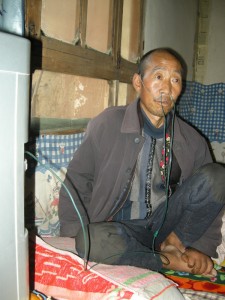Pneumoconiosis [1] is an occupational lung disease caused by the inhalation of dust. According to the Chinese government's official statistics, in 2010, 676,541 people were found to be suffering from pneumoconiosis and among them 149,110 people died as a result of the disease. The accumulative death rate was up to 22.04%.
The real incidence of the disease it likely to be much bigger, as rural migrant workers are systematically excluded from occupational disease statistics and are also not covered by the social security insurance system.
A netizen initiated charity project “Love Save Pneumoconiosis” was launched in mid 2011 and recently the group produced an advocacy video to explain the situation of rural Pneumoconiosis patients in China (see below).
Acopy.net has translated [2] the video's subtitles. Below is the video's opening script:
A special group of rural migrant workers: miners, construction workers, tunnel workers and metal workers.
Work and dust. They have contribute to the prosperity of the city with their sweat. They pay for our nice homes with their youth. They should be rewarded with happiness , but eventually their most luxurious dream is to be able to breathe.
Their dreams were to feed their families. To pursue after this dream, they left their homeland and stepped into the construction sites and mines…
“大爱清尘”宣传片:数百万尘肺病农民被死亡威胁 [3] from A Copy Workshop [4] on Vimeo [5].
Prominent investigative reporter Wang Keqin from Beijing is the project leader. He explained [6] [zh] the background of his involvement in his blog in December 2011:
许多人都在问,王老师,你为什么那么热衷救援中国尘肺病农民工?我的回答很简单:如果没有高考制度,我可能就是一个在煤窑打工的矿工,我也许就会成为一个在死亡线上苦苦挣扎的尘肺农民。
对于我的死活!当用工企业拒不负责、当相关部门置若罔闻、当债台高筑无力救治的时候,作为个体的生命,我想活下去——我渴望有人拉我一把,从死神那里把我抢回来!
When the companies refuse to take responsibility, the government units pretend they don't see the problem, while one doesn't have money to pay for the treatment but wants to live — I would hope that [if I were in this situation] someone would have helped me out and pulled me out from the grasp of the Devil.
作为一个新闻记者,我最早对尘肺病这三个字的了解,源于自己的一次采访。上世纪九十年代中期,作为《甘肃经济日报》的记者我在采访一乡村煤矿的产权纠纷时,认识了这里负责挖煤的副矿长老黄。和他在一起的时候,看到他常常咳嗽的上气不接下气,后来得知他是因长期在煤矿挖煤,接触了大量煤矿粉尘患了职业病,就是现在说的尘肺病。
没几年,他的工友来电,老黄死了,被尘肺病活活憋死了。
一个阶段,老黄的笑容总是出现在我的眼前,挥之不去。
A few years later, his colleague called me and told me that Old Huang had suffocated to death because of the pneumoconiosis.
For a long time now, the smiling face of Old Huang has kept lingering in my brain.
此后比较集中的关注尘肺病源于2009年。这年12月,当时在甘肃工作的当地媒体记者火兴才打来电话,说甘肃省古浪县有一百多个农民集体患上尘肺病,已有数人死亡,其他人的情况也很糟糕。农民求助媒体,地方媒体不让报道,期望我能关注。
Wang sent a reporter to Gansu to report on the situation. However, the report could not help the patients, who were dying. Interviewees passed away one by one in 2010. Wang decided to shift his reporting to social media forum Weibo to call for public attention in December 2010, and a number of netizens took immediate action to help out:
12月25日,“北京厨子”等人到达古浪,通过微博呼吁,更多的网友也紧随前往。一场【拯救121位古浪尘肺病农民兄弟大行动】启幕。
“北京厨子”等志愿者开始通过网络筹款,并组织几位患者到北戴河医院进行洗肺救治。
在媒体在强大压力下,甘肃省社保厅在接受焦点访谈采访时,表态要启动600万紧急救助。
接着,甘肃省武威市开始动员干部群众捐款数百万元。春节后,甘肃政府在强大的舆论压力下,正式决定由政府筹集专项基金1108万元,接盘古浪全体尘肺病农民的救治。
Under public opinion pressure the Social Security Bureau of Gansu province promised in a media interview that they would use the 6 million [RMB] emergency fund to help the patients.
Wuwei city of Gansu province also launched a donation campaign among government cadres and raised a few million RMB. After the spring festival, pressed by public opinion, the Gansu government set up an 11 million [RMB] fund to support the treatment of pneumoconiosis patients in Gansu.
Adopted by the China Social Assistance Foundation [8] in June 2011, the Love Save Pneumoconiosis project is a consolidation of netizens’ spontaneous efforts in helping out pneumoconiosis patients in China. The project [9] [zh] uses Weibo to collect information about pneumoconiosis victims in rural area and report on the project's work and spending.
